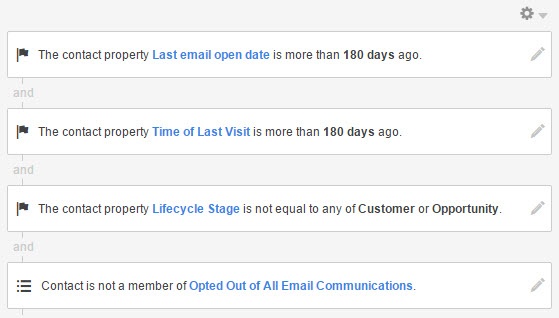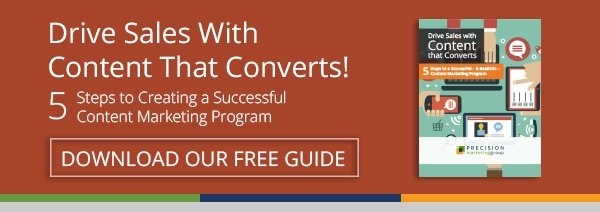Nobody wants to be that person. You know, the seemingly spammy marketer regularly adding to the deluge of unwanted emails flooding other people’s inboxes. They’re the worst, right? Delete. Delete. DELETE.
But as content-writing, traffic-building, lead-nurturing B2B enthusiasts, we also don’t want to give up on the once engaged contacts who are possibly still interested in our businesses (and potentially a purchase or referral down the road). Nor do we want to lose touch with those colleagues, partners and subscribers who had enjoyed consuming our content and sharing it on our behalf—and who simply need a little reminder that we’re committed to helping them scratch their pain point itch.
That said, thawing unengaged, cold contacts sometimes feels like fighting an uphill battle. Particularly when research shows that the average B2B database decays at a rate of 2.1% per month. That’s an annualized rate of 22.5%!
Of course, some of this decay occurs for reasons outside of our control – contact email addresses change due to new jobs or company acquisitions, unqualified leads opt out, and so on. And of course, you’ll find that many subscribers to your newsletter or blog are never going to be the right fit for your product or service; they’re just interested in the content you publish. And that’s great, too! (As long as they are engaging with it on a consistent basis… we’ll get to that in a bit).
So how exactly does an astute marketing pro go about:
- Winning back readership?
- Reigniting stale relationships with former leads?
- Cleaning out the cobweb-covered contacts that are contributing to database decay?
The solution is to launch a compelling re-engagement campaign.
Re-engagement campaigns are your opportunity to get back in the game, reinforce your value proposition, and remind your inactive subscribers why they were paying attention to your business in the first place.
Know that there isn't one correct way of running a re-engagement campaign. You could try creating a series of connected direct mail pieces, reaching out to your audience via social media, or using any number of other channels to reconnect. Clever outside-the-box ideas can really pay off! However, the vast majority of re-engagement campaigns are email based, particularly if what you’re trying to achieve is more active engagement with your email marketing efforts.
Why does active email engagement matter?
There are two primary drawbacks to hanging on to unengaged contacts and continually sending them emails they never open. For starters, your data analytics (email open rates and click rates, as well as lead conversion source reports) are going to skew in a negative direction, even if you are raking in new and engaged leads every month.
 More importantly, sending what’s known as graymail is a big marketing no-no. Internet Service Providers (ISPs) are getting smarter, so to speak, and they’re able to pick up on how contacts are engaging with your emails, and consequently, they become better at categorizing your emails over time.
More importantly, sending what’s known as graymail is a big marketing no-no. Internet Service Providers (ISPs) are getting smarter, so to speak, and they’re able to pick up on how contacts are engaging with your emails, and consequently, they become better at categorizing your emails over time.
For instance, if a contact subscribes to your newsletter, opens one of them, and then doesn’t open the next ten or so, ISPs will start considering your emails to be graymail – and automatically funneling them into the Promotions folder, Junk, etc. Even worse, if you continue to send emails to contacts who don’t open your emails, you’re reducing your engagement rates and damaging your sender score reputation, which actually impacts your ability to deliver your message to people who do want to hear from you. You could even end up blocked. Ouch!
If you are going to give these unengaged contacts another chance to be wooed by your magnificent messaging, it’s best to do it strategically. Below are six steps you should be taking to maximize your re-engagement campaign’s potential – as well as a few insights from our recent efforts to put these steps into practice.
Step 1. Identify the Contacts You Want to Re-engage
First and foremost, it’s critical that you define inactivity. There are two pieces of context to consider here—behavior and time. Start by targeting users who have not recently been to your website, and who also have not opened one of your emails in a while. Depending on your industry, benchmarks you may have established in the past, or how often you send out emails to your audience, the timeframe you’re evaluating may vary. Four to six months of inactivity is a logical choice for most B2B businesses.
So to rephrase, you’ll be identifying and attempting to re-engage contacts who have not visited your website in the last four to six months and who have not opened an email in the last four to six months.
Now, it’s time to create a list of contacts based on specific contact properties you have available in your CRM or database. Segment your contacts using this information (for a contact to join the list, they must meet all of the criteria):
- The contact’s last visit to the website was more than X days/months ago.
- The last time the contact opened an email occurred more than X days/months ago.
- The contact has not opted out of email communication (or marketing-related information) from your business.
- The contact’s Lifecycle Stage is not marked as Customer or Opportunity. You should create separate re-engagement campaigns for these types of contacts.

You may also want to exclude any contacts that represent lost deals or contacts that went through most of your sales process but then “went dark”. Again, these contacts should receive a more targeted set of emails if you’re going to try to re-engage with them. Moreover, you can also choose to sort out any contacts who you’ve already established are likely to never be qualified leads or evangelists for your business.
Finally, if you have enough data, it’s best to further segment contacts who meet all of the above criteria into multiple lists based on Industry, Job Role or whatever properties are most relevant to your target buyer persona(s). The numbers consistently demonstrate that more personalized email content drives greater engagement rates – so putting in the extra time to create customized campaigns can make a substantial difference in the end result.
Step 2. Define Re-engagement
How will you measure the success of your campaign? The primary goal, of course, is to compel recipients to open an email (and to not unsubscribe while doing so). However, you’ll also want to track email clicks and visits to your website.
Note: Don’t forget to take note of your current email marketing data (average open rates, click rates, website visits, lead conversions, customer conversions, etc. – for a period of six months or so prior to launching the re-engagement campaign). You can compare this to the data from the six months following the campaign and corresponding database cleanup.
Remember, once a contact meets your re-engagement goal, pull that contact out of the re-engagement campaign, and funnel him or her into another lead nurturing workflow geared towards active leads. With the right marketing automation software, this process can be extremely easy. If you don’t have a platform that automates this process, keep an eye on results after each email send, and manually remove a contact from the campaign list after they re-engage.
Step 3. Craft Your Emails
You already know that these contacts have not been responding to what you’ve been sending them in the past, so it’s time to change it up! These changes can apply to the subject line, the preview text and the actual content in the email. You could also try sending at a different time than usual—it could even be worth trying an email over the weekend. Whatever you’ve been doing… just do something else.
Here are a few alternative subject line ideas:
- Use personalization – including the contact’s first name, job role, or geographic location.
- Pose a question.
- Write the beginning half of a joke or riddle, referencing the contact's industry. Then include the punch line in the email. (Corny is okay, but please just test it out on an honest audience first).
- Make a self-deprecating remark about breakups – or just use more humor in general.
- Try the “long time no see” or “just checking in” approach.
- Steal an idea from the Obama campaign (analyzed by Kissmetrics).

How many emails you send is up to you, but we recommend three to five emails spaced 10-20 days apart. Again, this depends on how frequently you send out emails in the first place.
As for the content in your email, each one should have a very specific and singular Call-to-Action. Big, bright buttons or images that are easy to click (think mobile-friendly sizes) typically produce higher CTRs.
- Email 1: For your first send, it makes sense to simply highlight a new addition to your website, product or service, provide a link to your latest complimentary eBook, white paper or guide, or offer a compelling industry-based video or resource (just make sure it isn’t one they’ve already downloaded!)
- Emails 2-4: If email number 1 doesn’t resonate, it’s time to get down to business. It’s important that you overtly acknowledge (as succinctly as possible) that the contact has not been engaging with your company’s communication and resources, leveraging the space you have in the subject line, preview text and body copy. Keep things lighthearted and friendly, and be sure to let the readers know that you don’t want to be sending content they don’t want to receive. You’re on their side.
To sweeten the pot, you can offer an incentive to re-engage—a coupon, discount, or even a $10 gift card to Starbucks. You can also send out a content survey or poll with a small reward upon completion. Directly asking subscribers what types of content they want delivered from you is an effective way to tailor the experience to the reader and show that you genuinely care about their interests. Plus, you’ll have a few more ideas for your next blog post or newsletter feature. Try this tactic in a few different ways in a couple more emails. - Final Email: If your previous emails have not successfully re-engaged the recipient, make sure you foster a sense of urgency with the last one. Let the reader know that you will be unsubscribing them if they do not click on the link you provide to indicate they’d like to continue receiving your content. For this email, a click-through must be your re-engagement goal.
Step 4. Set Up a Smart Workflow
If you have the capabilities to do so, automate the entire re-engagement campaign! With marketing automation software, you can space your emails apart however you like. You can also funnel out contacts that do re-engage with your content or website – so you don’t continue sending them “please reconnect with us” emails after they already have!
First, create another contact list that includes your re-engagement goals. To join the list, the contact would only have to meet one of the following criteria (so use OR in your List Rules, as opposed to AND like before). For example, the criteria could include:
- The contact has visited the website in the last X days (X representing the total number of days you plan to run the re-engagement campaign, from first send to last send).
- The contact has opened Email 1, Email 2, Email 3, etc.
- The contact has clicked on a link in your Final Email.
Specify for each of these OR rules that they must still be opted into your email communication, and then you’re all set! Finally, when setting up your campaign’s automated workflow, indicate that once a contact has joined the Goal List, they do not receive any more re-engagement emails.
Step 5. Respond to Those Who Re-engage
If you run an effective campaign, you’re likely to receive some feedback from subscribers who don’t want to lose out on your helpful resources and information. Don’t forget to respond to anyone who emails you! And if you’re feeling particularly gutsy, you could even reach out to a contact who opens one of your campaign emails with a friendly “hello” – and ask them if there is any topic they’d like to read or hear about in your next piece of content. Just be sure to play it cool! Responsiveness is great; the feeling like you’re being watched... not so much.
Step 6. Assess Results – and Say Goodbye to Lost Causes
So how’d it go?! Take a look at your results and assess your success. For those contacts who remain unengaged, it’s time to go your separate ways. Vet the list one more time and make sure there isn’t anyone in the pile you want to save (a vendor or partner for instance). Then delete the rest.
A lot of people are uncomfortable with deleting a potentially large number of prospects out of their contact database in one foul swoop – and in some cases, that’s fine. It’s understandable that you want to hang onto their data, and the remote chance they might come back to you in the future. But remember the graymail concept! If you continue to send these unengaged contacts emails they aren’t going to open, you’re only hurting yourself. The least you can do is to move these contacts onto a “Do Not Email” or “Email Less Frequently” list.
Also keep in mind that if your re-engagement campaign worked well, you can set up a Smart List that continuously enrolls contacts who meet your starting criteria into your Re-engagement Workflow. That way, you’ll always be attempting to re-engage contacts as they hit that four-to-six month mark of inactivity.
Insights from Our Recent Re-engagement Campaign
Our agency, like any other business, has a living, breathing database that requires attention and maintenance. As we’ve steadily grown that database over time, we were starting to see our normally satisfactory monthly eNewsletter open rates and click-through rates slowly decline in 2016. Nothing too dramatic, but this was particularly surprising because we simultaneously saw a major uptick in blog subscribers and overall new contacts this past year.
To identify the issue, we dug into our analytics, and we found that 814 of our contacts had not been to our website or opened an email from us in over six months.
After an initial outline of the content for the various emails had been drafted, our marketing team deliberated over how many actual emails should comprise the campaign. We decided that this was a perfect opportunity to test two versions and report on the results to our readers.
One campaign contained a series of three emails. The other, five emails. The anti-climactic result of this A/B test was that the difference wasn’t very significant (the three-email series “won” by a few percentage points). Perhaps we should have tested three emails against seven or eight to accentuate the difference.
HOWEVER, there are a few interesting bits of information we did collect:
- Lighthearted subject lines go a long way! Our top performing subject lines were by far “A message from your long lost marketing pals” and “Uh oh… are we breaking up?”. In fact, the breakup email content prompted eleven different contacts to reach out to our team and personally let us know they were still interested in hearing from us. And the long lost marketing pals line led to a 12% open rate, which is pretty darn great considering the prior open rate for this group over the last six months was 0%.
- You win some, you lose some. Conversely, the “Uh oh… are we breaking up?” subject line (used for the last email in both campaigns) also exhibited the highest unsubscribe rate. The takeaway? People either like what you write or they don’t. Be compelling, but be yourself.
- Explicit = Click-worthy. Our agency's "Best of the Blog” recap email (only sent in the campaign with 5 emails) may have had the lowest open rate, but it also produced the highest click-through rate. This is a good example of why emails with straightforward subject lines can be helpful to your audience. People like to know what they’re getting, and they don’t like being disappointed by vague or misleading subject lines.
- Not everyone wants to be considered a lead. And, of course, we respect that! One of our emails prompted the reader to click on one of four links, each correlating with a specific statement describing how they might feel about our content. Several contacts indicated they simply enjoyed our educational content and no longer wanted to receive information about our outsourced marketing services. They were then brought to a dedicated landing page where they could modify their blog update notification frequency if they so desired.
The End Result?
 Overall, we successfully re-engaged 12% of the contacts we targeted. (And we decidedly deleted the rest of them.) High five!
Overall, we successfully re-engaged 12% of the contacts we targeted. (And we decidedly deleted the rest of them.) High five!
Since then:
- Our monthly newsletter open rates and click-through rates have nearly doubled.
- Our overall email deliverability rates have improved.
- Our overall email open rates and click-through rates have increased by about 50%.
To encourage even more engagement, we’ve recently implemented a monthly poll on our website (using Hotjar) that prompts our visitors to vote for one of three topics they’d like to read about. We’ve also happily answered several requests from our Ask the Experts page. So keep them coming!
Any other great re-engagement campaign ideas you’ve come across or used yourself? Post a comment below! And if you have any questions about re-engaging your own audience or implementing a better email strategy into your marketing program, let us know – We’re happy to help.




